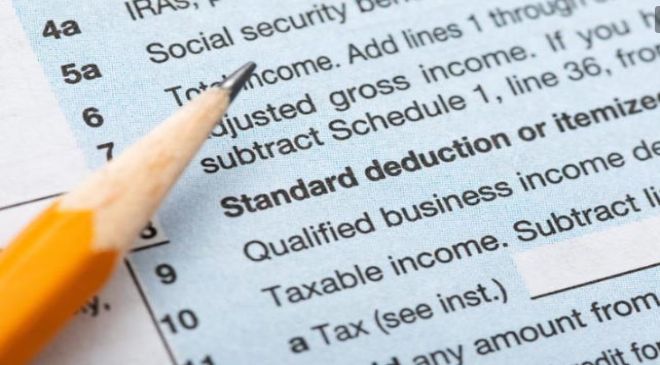The earned income tax credit directly reduces the amount of income tax owed by lower-income working taxpayers. Depending on a tax filer’s number of children, tax filing status, and income, the tax credit can be in the thousands.
Here’s what you need to know about the 2022 EITC tax refund schedule and the 2023 EITC numbers.
What Is the Earned Income Tax Credit (EITC)?
The earned income tax credit, also known as the earned income credit (EIC), is a credit that low- to moderate-income workers can claim on their tax returns to reduce federal income tax owed.
Singles or married couples must have some form of earned income to qualify. Above a certain income level, they aren’t eligible for the credit. The number of qualifying children is also a key component of the tax credit.
The credit ranges from $560 to $6,935 for the 2022 tax year (taxpayers filing by April 18, 2023) and from $600 to $7,430 for 2023.
Also Read– Gov. Whitmer announces amount for proposed ‘Inflation Relief Check’
For those filing federal returns in 2023, the maximum allowable adjusted gross income (AGI) is $59,187 for a married couple filing jointly who have three or more children. Tables with amounts for the tax credit and maximum AGI are in the next section.
At the very least, the EITC reduces the amount of tax owed. At best, low-income people who have little or no income tax liability can receive the total credit in the form of a tax refund.
How Does the Earned Income Tax Credit Work?
The EITC is a fairly complicated credit, even for taxpayers who are not filing taxes for the first time. In fact, the IRS sees errors in close to 25% of tax returns claiming it. Online tax filing software can help. The IRS also offers an “EITC Assistant” calculator.
The amount of the credit depends on the tax filer’s number of qualifying children, filing status, and earned income or AGI. (AGI is defined as gross income — including wages, dividends, capital gains, business income, and retirement distributions — minus adjustments to income, which can be student loan interest, contributions to a retirement account, educator expenses, or alimony payments.)
Investment income must be $10,300 or less in 2022 ($11,000 or less in 2023).
On your tax form, the credit is filed under the “payments” section, which is a way for the credit to be directly applied dollar for dollar to any income tax you owe.
Also Read– Column: Mike Pence, would-be president, has a plan to kill Social Security. It will cost you
Workers receive the credit beginning with their first dollar of earned income. The amount of the credit rises with earned income until it reaches a maximum level. Then it begins to phase out at higher income levels.
Taxpayers with earned income or AGI above a certain level won’t qualify for the tax credit at all. These amounts are listed below for tax years 2022 and 2023.

Phaseout amount begins at:
Also Read– Gold giant Newmont’s $16.9 billion bid for Australia’s Newcrest clouded by deal doubts
• Single, head of household, or widowed: $9,160 for no children; $20,130 with qualifying children.
• Married filing jointly: $15,290 for no children; $26,260 with qualifying children.

Phaseout amount begins at:
• Single, head of household, or widowed: $9,800 for no children; $21,560 with qualifying children.
• Married filing jointly: $16,370 for no children; $28,120 with qualifying children.
Who Qualifies for the EITC?
To qualify for the EITC, you must have earned income and meet certain AGI requirements.
Types of income include:
• W-2 wages from employment
• Self-employment (or gig or freelance) earnings
• Certain disability benefits
• Benefits from a union strike
• Nontaxable combat pay
You do not have to include income from the following sources:
• Social Security
• Child support or alimony
• Unemployment benefits
• Pensions or annuities
• Interest and dividends
• Pay as a prison inmate
What Are ‘Qualifying Children’?
To claim a child for the EITC, a qualifying child must have a valid Social Security number, meet the four tests of a qualifying child, and cannot be claimed by more than one person.
The four tests for a qualifying child are:
• Age: A qualifying child can be of any age if they are permanently and totally disabled; under age 19 at the end of the year and younger than you; or under age 24 at the end of the year and a full-time student for at least five months of the year and younger than you.
• Relationship: A qualifying child can be a son, daughter, stepchild, adopted child, foster child, brother, sister, half brother, half sister, stepsister, stepbrother, grandchild, niece, or nephew.
• Residency: The child lived with you in your home for more than half the year.
• Joint return: The child is not filing a joint return with anyone, such as a spouse, to claim any tax credits like the EITC.
• Relationship: A qualifying child can be a son, daughter, stepchild, adopted child, foster child, brother, sister, half brother, half sister, stepsister, stepbrother, grandchild, niece, or nephew.
• Residency: The child lived with you in your home for more than half the year.
• Joint return: The child is not filing a joint return with anyone, such as a spouse, to claim any tax credits like the EITC.
Can You Claim the EITC If You Have No Children?
It is possible to claim the EITC if you have no children, but the income threshold is very low and the credit is small.
For tax year 2022, the maximum credit is $560 for filers without children. The maximum adjusted gross income is $16,480 for taxpayers filing as single, head of household, or widowed and $22,610 for married couples filing jointly.
Also Read– How To Save $10,000 in a Year: 10 Steps
For tax year 2023, the maximum credit is $600. The income figures are in the table above.
Requirements include:
• A valid Social Security number
• Not filing Form 2555 (foreign earned income)
• Main home is in the U.S. for more than half the year
• Not claimed as a dependent or qualifying child on another tax return
• You are at least 19 (or 24 if you were at least a part-time student for at least five months of the year, or at least 18 if you are a former foster child after turning 14 or a homeless youth)
There are also special qualifying rules for clergy, members of the military, and taxpayers and their relatives who receive disability payments.
How the EITC Can Affect When You Receive Your Refund
Your tax refund may be delayed if you claim the EITC and file early in the year. The IRS is required to wait until mid-February to issue refunds when the EITC is claimed.
Expect a tax refund by March 1, assuming there were no issues with your tax return and you opted for direct deposit, the IRS says.
Common Errors to Avoid When Claiming the EITC
Also Read– The housing market correction, as told by 4 charts
The IRS lists five snags to avoid when claiming the earned income credit.
1. Your child doesn’t qualify: The IRS states that most errors occur because the child doesn’t meet the four requirements relating to relationship, residency, age, and filing status.
2. More than one person claimed the child: Only one person can claim the qualifying child. If the child counts as a qualifying child for more than one person (such as separated or divorced parents), the IRS has some guidelines on how to choose which person can claim the qualifying child.
3. Social Security number or last name doesn’t match card: The Social Security number and name must be exactly how they appear on the Social Security card.
4. Married and filed as single or head of household: Taxpayers cannot claim the EITC if they are married and file as single or head of household.
5. Over- or underreported income or expenses: Be sure to include all types of income from IRS Forms W-2, W-2G, 1099-MISC, 1099-NEC, and other income unless it’s one of the exceptions listed above.
The Takeaway
The EITC offers income tax relief for lower-income workers. If you think you might qualify, look at the EITC tax refund schedules, seek tax help if you need to, and file electronically for a speedier refund.
Also Read– Column: Mike Pence, would-be president, has a plan to kill Social Security. It will cost you
While filing taxes isn’t most people’s idea of fun, a free money tracker app can make keeping your financial house in order much easier.
FAQ
When should I expect my EITC refund?
According to the IRS, a refund with an EITC will arrive around March 1 if you filed electronically and elected for direct deposit, and there were no issues with your return. By law, the IRS cannot issue a tax refund with an EITC before mid-February.
Most taxpayers of all stripes who file electronically should get a refund within 21 days, the IRS said in January 2023.
Will there be an EITC in 2023?
Yes, there is an EITC for 2023. It rises to a maximum of $7,430 for the 2023 tax year.
Will tax refunds be bigger in 2023?
Also Read– Gold giant Newmont’s $16.9 billion bid for Australia’s Newcrest clouded by deal doubts
No, not in general. Many taxpayers could see significantly smaller refunds in 2023, the IRS says, thanks to the expiration of expanded tax credits that served as pandemic relief. For the EITC, a taxpayer with no children who received an earned income credit of $1,502 in 2021 will receive a credit of $560 for tax year 2022 ($600 for 2023).

























